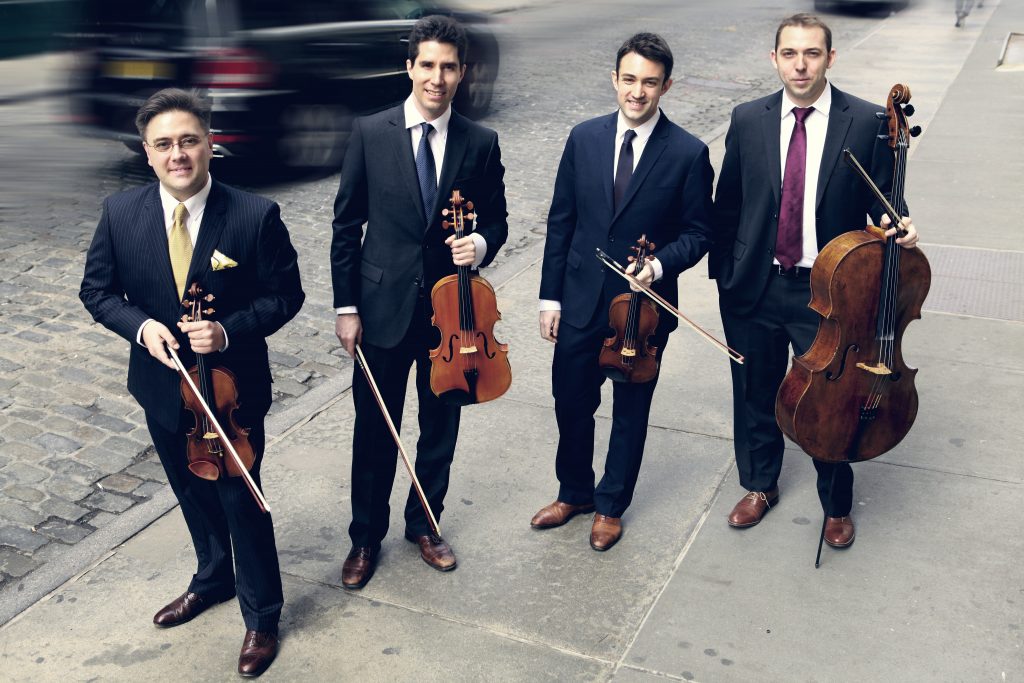Music in Avant-Garde Vienna a Century Ago
With the exception of an effervescent concert-opening performance of Mozart’s familiar Piano Quartet in G Minor, K. 478, Friday’s (August 12) La Jolla SummerFest program was devoted to works from the exciting but contradictory musical landscape of Vienna during the first half of the 20th century. We experienced the gamut of styles from Anton Webern’s minimal atonalism, his Six Bagatelles for String Quartet, Op. 9, to Alexander Zemlinsky’s expressionist Fourth String Quartet, to Erich Korngold’s arch-Romantic Piano Quintet in E Major, Op. 15.
Strangely, the earliest of these three pieces, Webern’s 1913 Six Bagatelles, proved the most radical. Members of the Verona Quartet gave a taut, meticulously detailed but sonically vibrant account of this austere piece. In Webern’s condensed vocabulary, a phrase may consist of two notes, a development section may be an extended trill, and all four members of the quartet play together simultaneously only in brief moments of climax. In the words of Webern’s mentor Arnold Schoenberg, this piece is “a novel expressed in a single gesture.”The Verona Quartet’s poise and dramatic ardor under the constraints of this idiom were admirable, and the ensemble did us the favor of playing this short work twice to savor its effect. I was particularly taken with the sheer beauty of cellist Warren Hagerty’s impeccable, short melodic snippets and with second violinist Dorothy Ro’s incendiary trills. Violinist Jonathan Ong and violist Abigail Rojansky completed this stellar young string quartet.
We remember the Austrian musician Alexander Zemlinsky more as Schoenberg’s counterpoint teacher than we do for his compositions, but they deserve consideration. The Escher String Quartet made a compelling case for Zemlinsky’s 1936 Fourth String Quartet, Op. 25, a long, rigorously structured six-movement affair. From the first movement’s solemn chords and dark harmonic progressions, the entire work oozes Expressionist angst and adds to that mood a fashionable (for the 1930s) neoclassical contrapuntal structure. The final movement is a double fugue, no less.
Escher’s ardent approach to this string quartet stressed eloquence, even when the movement did not sound particularly uplifting. Cellist Brook Speltz’s full, nicely rounded sonority provided a muscular foundaton for the quartet, and violist Pierre Lapointe came through with assertive, mellow solos, especially in the antic Burleske movement. First violinist Adam Barnett-Hart led with acute, decisive phrasing, although with second violin Aaron Boyd, he could communicate tender pathos when called upon.
Because Zemlinsky could not find a quartet to perform his demanding Fourth Quartet in Vienna, he never heard it performed. Less than two years after he finished it, he escaped Austria just before it was annexed to Hitler’s Third Reich and settled in the U.S., where he died in obscurity in 1942. Had he heard it in performance, he might have trimmed some of its more prolix passages, but it was a privilege to hear the Escher String Quartet play the work in this festival.
With the young Finnish pianist Juho Pohjonen, Escher explored another stylistic option, Korngold’s 1921 Quintet for Piano and Strings, Op. 15. This piano quintet boasts an unstinting effusion of robust, sweeping themes powered by the mighty harmonic vocabulary of ripe Romanticism, frequently sounding as if unused themes from Richard Strauss’ opera Der Rosenkavalier were carefully recycled into this mellifluous chamber work. No wonder by the early 1930s Hollywood was eager to sign up Korngold to compose scores for its motion pictures, a career move that, among other things, won him two Oscars and much acclaim on this side of the Atlantic.
Escher and Pohjonen held back nothing in reserve, giving an effulgent, gratifying account of the Korngold. In 1921 western music was going in various new directions, and this piano quintet was retrograde from the day of its first performance. But this performance sent the La Jolla audience home in a buoyant mood.
[themify_box style=”shadow”]
This concert sponsored by the La Jolla Music Society was given on Friday, August 12, 2016, at the San Diego Museum of Contemporary Art’s Sherwood Auditorium. SummerFest 2016 continues through August 26, 2016, in the same venue.
[/themify_box]




Great review — but for “effervescent” I would have substituted “egregious”.
I would have substituted “muddy” as to the piano in places where effervescence would have been welcome.